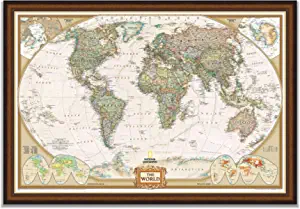Largest Countries in the World - Top
10 Largest Countries
 |
| WORLD MAP |
Wall Art for Living Room Click to Buy 👉 AMAZON
Top 10 Largest Countries in the World (Area Wise):
|
Rank |
Country |
Area |
% of Earth's Area |
|
1 |
17,098,242 km² |
11.52% |
|
|
2 |
9,984,670 km² |
6.73% |
|
|
3 |
9,706,961 km² |
6.54% |
|
|
4 |
9,372,610 km² |
6.31% |
|
|
5 |
8,515,767 km² |
5.74% |
|
|
6 |
7,692,024 km² |
5.18% |
|
|
7 |
3,287,590 km² |
2.21% |
|
|
8 |
2,780,400 km² |
1.87% |
|
|
9 |
2,724,900 km² |
1.84% |
|
|
10 |
2,381,741 km² |
1.60% |
Top 10 Largest Countries in the World (Population Wise):
|
Rank |
Country |
Population |
The largest country in the world is Russia, which spans a vast 17,098,250 km² across Eastern Europe and Asia. This is followed by Canada (9,879,750 km²) and its aforementioned two million lakes.
The country ranked third changes depending
upon the source of the comparison. Encyclopedia Britannica gives the third slot
to China (9,600,013 km²) and places the United States in fourth. However, other
sources, such as the United Nations and the CIA World Factbook, display a
larger area for the U.S. and rank it above China.
The difference between the high and low estimates for the U.S. appears to be because one includes coastal and territorial waters, but the other does not. However, considering China's area does not seem to include coastal and territorial waters, and the U.S. is smaller than China until those waters are added to the mix, we'd give the nod to China. Source-to-source discrepancies such as this are common, even understandable.
Determining the precise area of a sizable and irregularly shaped landmass is no small task, and there are no universally accepted guidelines for completing it. Some countries may measure their area using satellite surveys, and others may rely upon mathematical computations and manual estimates.
Moreover, different countries have different philosophies regarding the inclusion of areas such as overseas territories, disputed regions, and (as mentioned above) various bodies of water.
Whichever countries
are third- and fourth-largest, South America's
largest country, Brazil (8,515,770 km²), has a lock on fifth place. The only
country in the world with the exact same name as its continent, Australia
(7,714,220 km²), rounds out the top six.
Technically, the largest country in both Asia and Europe is Russia. However, because Russia is considered a European country in terms of culture and population, many sources designate Russia as the largest European country and grant the title of Asia's largest country to China. After Russia, the second-largest country in Europe is another judgment call: If considering the area of the mainland only, Ukraine's 603,550 km² would be the second-largest area.
However, if
one counts not only mainland France
but also its overseas departments (such as Martinique and Mayotte), its area swells to 640,679 km², giving France the edge. Africa's largest country is Algeria (2,381,741 km²).
The smallest countries in the world are predominantly in Europe, Oceania, and the Americas. Vatican City is
the smallest country in the world at a tiny 0.44 km², followed by Monaco at 2.02 km², both in Europe. Next are Nauru (21 km²) and Tuvalu
(26 km²), both island countries in Oceania. The smallest country in the
Americas is another island country, Saint Kitts and Nevis, which has an area of
only 261 km².
Finally, what if the phrase
"largest country" is actually a reference to a country's population rather than its physical size? The countries with the largest
populations on Earth are (in
order): China, India, the United States, Indonesia,
and Pakistan. For a full list of the largest (and smallest) countries in
the world, check out the table below.
 |
|
Very Great Information 👍
ReplyDelete